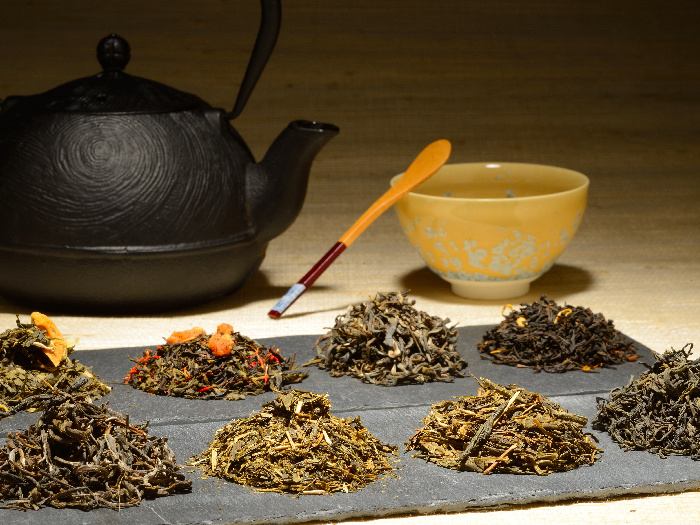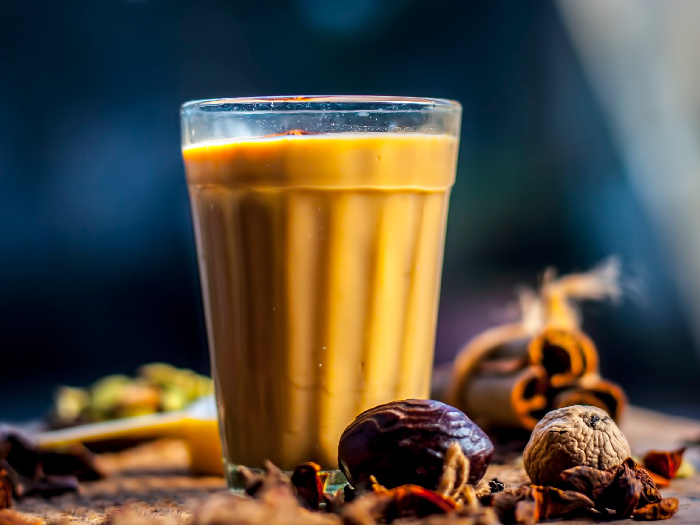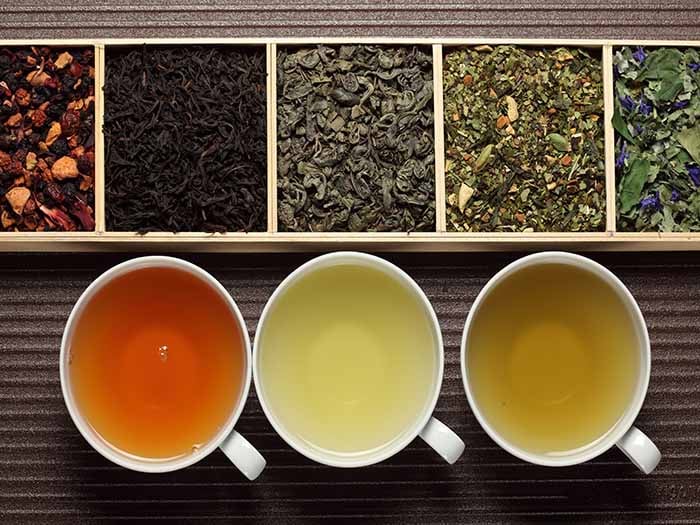Oolong, Earl Grey, matcha, hibiscus tea, vanilla chai latte – if you are an outsider to the tea world, it may be quite intimidating to navigate through the different types of tea available. Specialty tea shops take it a step further with their extensive menus offering teas from the classic to the contemporary and while you may know your Darjeeling, perhaps a Darjeeling first flush may leave you puzzled. However, don’t fret – let’s get a sneak peek into the basics of the tea world to understand it better.
A Beginner’s Guide to Types of Tea
Tea is the most widely consumed beverage in the world after water and with new varieties entering the market, the reach may get even wider. The tea story begins with the leaves and leaf buds of certain varieties of an evergreen shrub, Camellia sinensis. Two principal varieties, the China plant C. sinensis var. sinensis and the clonal Assam plant, C. sinensis var. assamica, are used for most teas. To make tea, these tea leaves are steeped in hot water and strained. Tea has a slightly bitter taste and produces a stimulating effect due to the presence of caffeine. [1] [2] [3]
Teas made from the Camellia sinensis are categorized mainly by the way the tea leaves are processed. The six main types of tea are white, yellow, green, oolong, black, and dark (post-fermented) tea. Let us look at them in detail.
White Tea
White tea is the most delicate of all tea varieties because it is minimally processed. White tea is either produced from unopened young buds, known as silver needles or a mix of a young bud and 2 immature tea leaves, covered in white leaf hairs. [4]
If you are brewing white tea for the first time, you may see that the tea is the palest shade of yellow and is characterized by the appearance of visible white hairs. White tea has a subtle tea taste and is best enjoyed without additives like milk or honey.
Popular white tea varieties include:
- Bai Hao Yin Zhen (silver needle)
- Bai Mudan (white peony)
- Monkey Picked White Tea (rumored to once harvested by Buddhist-trained monkeys!)
- Darjeeling White Tea
Yellow Tea
Yellow tea is rare and expensive and its production is considered an art form. The young tea buds are pan-fired and wrapped in a special cloth, and this procedure is repeated several times for three days to gently oxidize the tea leaves. This step called “sealed yellowing” helps trap the aroma in the buds. [5]
When steeped in hot water, you get a lovely yellow-colored tea with an enticing aroma and a sweet, mellow taste. The top varieties of yellow tea include:
- Junshan Yinzhen Tea (one of the rarest yellow teas)
- Mengding Huangyan
- Huoshan Huangyan
- Yellow Little Leaf Tea
- Yellow Large Leaf Tea
Green Tea
When the Chinese refer to tea, they generally mean green tea. This tea variety is one of the most researched types of tea, due to its high level of antioxidants and health properties. For green tea, the tea leaves are harvested and then quickly pan-roasted or steamed. The tea leaves are then dried to prevent excess oxidation. This is what helps the green leaves not brown too much and allows them to retain a grass-like, fresh-picked taste. [6]
While green teas are grown and produced all over the world today, the most popular types come from the place the tea originated – China and Japan.
Popular green teas from China, characterized by pan-roasting, include:
- Longjing, also known as Dragonwell
- Gunpowder (tea leaves are rolled into small, round pellets)
- Jasmine Pearl Green Tea (green tea, lightly scented with fresh jasmine petals, and shaped into pearls)
The well-known green teas from Japan, made with a steaming process, are:
- Sencha
- Hojicha
- Genmaicha (a blend of Sencha and roasted, popped rice)
- Gyokoro
- Matcha (the tea leaves are ground into a powder and are essential to Japanese tea ceremonies)
While most green teas are enjoyed without any additives, Kashmiri Kahwah tea is a delicious, fragrant green tea flavored with whole spices like cinnamon and cardamom, saffron, and almonds.

Different types of green tea Photo Credit: Shutterstock
Oolong Tea
Oolong tea lies somewhere between green tea and black tea, depending on the oxidation level on the tea leaves. The taste of the oolong may have the mildness of a green tea or the astringent taste of black tea. Oolong tea leaves are usually artisanally twisted, curled, or rolled into long, thin strands. Let us look at top oolong varieties: [7]
- Phoenix Tea (Dan Chong or Dan Cong)
- Iron Goddess of Mercy (Ti Kuan Yin or Tie Guan Yin)
- Red Robe Tea (Wuyi Oolong Tea or Da Hong Pao)
- High Mountain Oolong Tea (Gaoshan)
- Milk Oolong Tea or Jin Xuan Tea (an oolong with a creamy taste and a smooth finish)
Black Tea
This is the tea that most tea lovers across the world refer to. If you have to make a masala chai in India or an English breakfast in the UK or a sweet tea in the southern US, you usually use black tea. In China, black tea may also be referred to as red tea. Black tea is produced when the tea leaves are fully oxidized and turn a mahogany brown or deep black. The taste, depending on the color of the tea leaves, can range from malty, smoky, to even fruity tones. Black teas are usually full-bodied and can be also enjoyed with milk, cream, and sweeteners. The well-known Indian masala chai is made by simmering black tea with spices like cinnamon, cardamom, and ginger, and sweetened with sugar.
Four popular black tea varieties include:
- Assam (a bold-flavored tea from India)
- Darjeeling (a softer tea from India)
- Ceylon (from Sri Lanka)
- Kenyan
Black Tea Blends
Black tea has been historically also used to make tea blends, which have become household favorites. The top five tea blends include:
- Earl Grey Tea: A quintessential British tea flavored with the citrusy oil from the rind of bergamot oranges.
- English Breakfast Blend: Usually served with a traditional English breakfast, it is a blend of Assam, Ceylon, and Kenyan.
- Irish Breakfast Blend: A blend of strong black teas, with a larger proportion of Assam, giving it a malty taste.
- English Afternoon Blend: Served during high tea with sandwiches, this is a lighter version of the breakfast blend.
- Masala Chai Blend: A blend of black tea, spices, milk, and sweeteners like sugar or honey, an adaption of the Indian chai.

Masala tea or masala chai Photo Credit: Shutterstock
Post-fermented Tea or Dark Tea
Dark tea, or Hei Cha, is an aged tea from China and the aging process is an ancient process, which is closely guarded. When the tea leaves age, the bacteria react with the tea leaves and change the flavor, aroma, and appearance of the tea leaves. Dark tea originated in the Hunan province. The other well-known post-fermented tea is Pu-erh or puer tea, which is only made in the Yunnan province. Both, dark tea and puer tea are probiotic, but puer tea has a slightly more assertive earthy aroma than dark tea.
While a fine, dark tea can be had without additives, this type of tea lends itself to be accompanied by yogurt, goat milk, spices, or nuts. Dark tea is usually molded and preserved in different forms such as bricks, discs, cubes, bamboos, and sometimes, even in ornamental shapes like pomelo or an orange.
Herbal Tea or Tisane
Technically, if a beverage does not have the tea leaves from Camellia sinensis, it is not a tea. However, due to clever marketing, several hot drinks have been labeled as herbal tea. Generally, herbal teas or tisanes do not contain tea leaves and are usually infusions of herbs, spices, flowers, fruits, leaves, bark, or roots of a plant. So while a grassy-tasting rooibos ‘tea’ can be served to you, remember that it is a drink made by steeping the fermented leaves of a shrub found in South Africa and does not contain tea leaves.
FAQs
What is First Flush and Second Flush Tea?
In a tea plant, only the top 1-2 inches of buds and leaves are picked. These batches of tea leaves are called flushes. A plant will grow a new flush every week or at the most, a fortnight, during the growing season. Generally, the first flush is prized for its delicate and fresh taste and is more expensive than the second flush. However, it depends on taste. If you prefer bolder-tasting tea, then the second flush may be the right tea for you. [8]
What are the Packaged Types Of Tea Available in the Supermarket?
Tea is marketed in the following forms:
- Whole-leaf tea: Whole, unbroken tea leaves.
- Loose-leaf tea: Tea leaves that may be whole or naturally broken during processing.
- Teabags: Tea leaves or tea powder packaged in bags for easy infusion.
- Tea powder: Powdered form of tea leaves.
- Instant tea: Blend of tea extract, sugar, and evaporated milk that reconstitutes into tea on the addition of hot water.
Is Loose Leaf Tea Better than Teabags?
Tea snobs will tell you that loose leaf tea is always the right choice. Here’s why :
- Low-grade tea: Many teabags contain low tea grades such as tea dust and fannings. Dust and fannings are smaller pieces of tea, which taste stale as they have lost the essential oils.
- Infusion area: Loose leaves, when steeped, have room to absorb water, expand, and infuse flavor. On the other hand, the infusion of tea bags is limited to the size of the teabag.
- Quality of teabag: Some companies use cheap, bleached or heavily processed paper or plastic teabags that impart a dull taste to the tea, and may even be toxic. [9]
However, many companies are now investing in high-quality pyramid-shaped teabags or bigger-sized teabags to give the tea drinker a better experience. You can also get teabags with loose leaves as it does offer convenience. It’s a matter of personal choice and also, it may take time to scout the best teabags that work for you.


